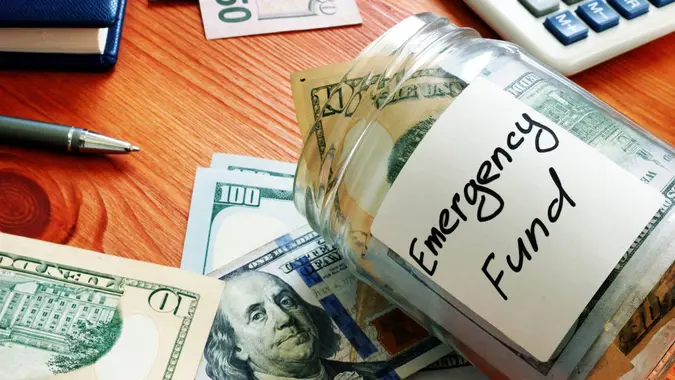5 Things You Should Never Do If You Want Your Savings To Reach $50K

Commitment to Our Readers
GOBankingRates' editorial team is committed to bringing you unbiased reviews and information. We use data-driven methodologies to evaluate financial products and services - our reviews and ratings are not influenced by advertisers. You can read more about our editorial guidelines and our products and services review methodology.

20 Years
Helping You Live Richer

Reviewed
by Experts

Trusted by
Millions of Readers
For many people, $50,000 could represent six months to a year of emergency savings. But William Stern, founder and co-CEO at small business lender Cardiff said he views it as an “opportunity fund,” instead. “It’s the money you use to strike should the market crash or the perfect deal magically appear. It’s the price at the table for real wealth,” he added.
Whether you’re saving for financial security and peace of mind, a big event or future investments, experts advise keeping sight of your goal and never making these money mistakes.
Never Rely on a Traditional Savings Account
The national savings account interest rate is less than 0.40% right now, according to the FDIC. Some larger banks, like Chase, deliver a low APY of just 0.01%. While it may be tempting to use the same bank for savings as everyday checking, your money won’t grow very quickly in a low-yield account.
“Why would you want to earn less when, for a similar amount of effort, you could potentially earn more?” said Julie Guntrip of Jenius Bank. Instead, choose a high-yield savings account with 4% APY or more. “Make sure to choose an account that doesn’t charge fees and is FDIC-insured,” Guntrip said.
Never Keep Savings Too Accessible
There’s another benefit to that high-yield online account — it may require an extra step to retrieve your money. “If your long-term funds sit in the same place as your daily spending, it becomes tempting to dip into them,” Guntrip said. “Creating a separate high-yield account for your savings goals helps to protect your funds from impulse spending.”
Never Automate Your Savings
Automating savings, even if it’s just $50 a week, might sound like a good idea to help you stay on track with your savings goals. But Stern said this isn’t the best way to amass $50,000 quickly.
“It’s a psychological anesthetic to make you feel like you’re making progress, when you’re actually just crawling,” he said. “The day you get paid, you need to manually transfer a sum so large that it hurts. That pain is what’s going to force you to adjust your life to meet your goal.”
Never Pay Yourself Last
Guntrip and Stern agreed that you should never think of your savings as your last financial priority. “Hoping to set aside ‘whatever is left’ rarely works because it’s always easy to find something else to spend on,” Guntrip said.
Stern agreed. “Your savings goal is the first payment that you make. It is the non-negotiable tax you pay your future self. You don’t save what’s left after spending, you spend what’s left after saving,” he added.
Never Ignore High-Interest Debt
There’s one exception to the “pay yourself first” rule: pay down high-interest debt before focusing on saving large sums of money. “That 22% credit card balance, that’s a parasite and it’s eating your savings goal alive,” Stern said. “Every extra dollar that you have must be used to kill that parasite. Only then can you start building your war chest.”
Guntrip had advice once you’ve paid down the high-interest debt. “Create a rule that you won’t spend on credit if you can’t pay the balance when it’s due. You’ll thank yourself later when you’ve met your savings goal,” Guntrip added.
More From GOBankingRates
- Nearly 1 in 3 Americans Hit by a Costly Holiday Scam, Norton Survey Shows -- How To Avoid This
- Here's What the Average Social Security Payment Will Be in Winter 2025
- How Middle-Class Earners Are Quietly Becoming Millionaires -- and How You Can, Too
- The Easiest Way to Score $250 for Things You Already Do
 Written by
Written by  Edited by
Edited by 


























